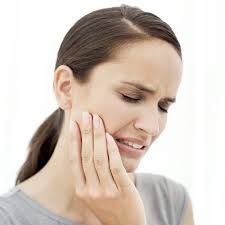 Your temporomandibular joints, or TMJs, are the small joints that connect the mandible (lower jaw) to the temporal bones in your skull, located just in front of each ear. The two joints work together to move the lower jaw as you bite, chew, yawn, speak, and swallow. When these joints are exposed to excessive pressure, they can become damaged, leading to a wide range of pains and sometimes difficulty moving the jaw. The jaw dysfunction encompasses a wide range of aches and pains, and diagnosis may be difficult because of the diversity of TMJ disorder’s symptoms. Luckily, your Beverly Hills orthodontist, Dr. David Alpan, is highly-skilled and specially-trained to diagnosis and treat TMJ disorder, and has helped many patients find relief from the condition. Continue reading How to Diagnose and Treat TMJ Disorder (TMD)
Your temporomandibular joints, or TMJs, are the small joints that connect the mandible (lower jaw) to the temporal bones in your skull, located just in front of each ear. The two joints work together to move the lower jaw as you bite, chew, yawn, speak, and swallow. When these joints are exposed to excessive pressure, they can become damaged, leading to a wide range of pains and sometimes difficulty moving the jaw. The jaw dysfunction encompasses a wide range of aches and pains, and diagnosis may be difficult because of the diversity of TMJ disorder’s symptoms. Luckily, your Beverly Hills orthodontist, Dr. David Alpan, is highly-skilled and specially-trained to diagnosis and treat TMJ disorder, and has helped many patients find relief from the condition. Continue reading How to Diagnose and Treat TMJ Disorder (TMD)
Los Angeles Orthodontist Answers Questions About TMJs
What to Know About TMJ Disorder
 Most crooked teeth are inherently visible when patients smile, their unevenness disturbing what should be a perfectly balanced arrangement of teeth. However, not all of the effects of malocclusion (crooked teeth) involve visual appearance. When left untreated, a disproportionate bite can prove devastating by forcing the components of a patient’s mouth to absorb more pressure than they were designed to withstand. Often, it can lead to debilitating discomfort in the form of TMJ disorder, which describes damaged, inflamed, and/or misaligned jaw joints. As a dedicated orthodontist in Los Angeles, Dr. David Alpan has helped many patients find TMJ relief by correcting malocclusion, and by educating patients about the jaw dysfunction.
Most crooked teeth are inherently visible when patients smile, their unevenness disturbing what should be a perfectly balanced arrangement of teeth. However, not all of the effects of malocclusion (crooked teeth) involve visual appearance. When left untreated, a disproportionate bite can prove devastating by forcing the components of a patient’s mouth to absorb more pressure than they were designed to withstand. Often, it can lead to debilitating discomfort in the form of TMJ disorder, which describes damaged, inflamed, and/or misaligned jaw joints. As a dedicated orthodontist in Los Angeles, Dr. David Alpan has helped many patients find TMJ relief by correcting malocclusion, and by educating patients about the jaw dysfunction.
What does TMJ stand for?
TMJs are the temporomandibular joints that connect the lower jaw, or mandible, to the temporal bones in the skull. Located in front of each ear, TMJs move in tandem as the jaw opens and closes, and rely on proper balance to repeatedly absorb bite pressure without sustaining damage. Continue reading Los Angeles Orthodontist Answers Questions About TMJs
Los Angeles Orthodontist on Teeth Alignment & TMJ Disorder
 As a dedicated orthodontist in Los Angeles, Dr. David Alpan has helped patients of all ages improve their confidence by straightening crooked teeth. He also warns that straight teeth are about more than mere vanity; proper occlusion, or teeth alignment, is vital to a mouth’s comfort, health, and function, and when teeth are crooked (a condition called malocclusion), the rest of your mouth’s components can suffer. Today, we explore how crooked teeth can influence your jaw’s joints and muscles, leading to the debilitating dysfunction known as TMJ disorder.
As a dedicated orthodontist in Los Angeles, Dr. David Alpan has helped patients of all ages improve their confidence by straightening crooked teeth. He also warns that straight teeth are about more than mere vanity; proper occlusion, or teeth alignment, is vital to a mouth’s comfort, health, and function, and when teeth are crooked (a condition called malocclusion), the rest of your mouth’s components can suffer. Today, we explore how crooked teeth can influence your jaw’s joints and muscles, leading to the debilitating dysfunction known as TMJ disorder.
The Effects of Improper Pressure Displacement
A healthy human mouth can exert up to 200 pounds of pressure on the back molars when biting and chewing, and is designed to preserve the integrity of its components as they absorb this pressure. Teeth alignment plays a significant role in pressure displacement, and if teeth are uneven, then the mouth is off balance and certain teeth may be subjected to excessive pressure. The jaw’s joints (TMJs) and muscles will try to keep the mouth straight while biting and chewing, but the strain can eventually lead to TMJ damage and misalignment. Continue reading Los Angeles Orthodontist on Teeth Alignment & TMJ Disorder
Los Angeles Orthodontist Explains TMJ Disorder
 There are a host of issues that can arise from crooked teeth, including the diminished confidence of a less-than-appealing smile, but your teeth’s alignment is about more than looks; it’s about balance, which is a necessary component of a well-functioning mouth. Your Los Angeles orthodontist, Dr. David Alpan, believes it’s important to know the intricacies of your oral health, and enjoys helping patients find their smiles’ perfect balance through customized orthodontic treatment. Today, we explore a vital dysfunction that can result from unattended crooked teeth called TMJ disorder, which can negatively affect your smile’s integrity and the components that make it move.
There are a host of issues that can arise from crooked teeth, including the diminished confidence of a less-than-appealing smile, but your teeth’s alignment is about more than looks; it’s about balance, which is a necessary component of a well-functioning mouth. Your Los Angeles orthodontist, Dr. David Alpan, believes it’s important to know the intricacies of your oral health, and enjoys helping patients find their smiles’ perfect balance through customized orthodontic treatment. Today, we explore a vital dysfunction that can result from unattended crooked teeth called TMJ disorder, which can negatively affect your smile’s integrity and the components that make it move.
Why Balance is Important
Your jaw is hinged to your skull at the temporal bones in front of each ear, and the temporomandibular joints (TMJs) move in tandem as your mouth opens and closes. When healthy and perfectly-aligned, your jaw displaces the pressure of your bite evenly among the joints and muscles that move it and the teeth that absorb the impact. Continue reading Los Angeles Orthodontist Explains TMJ Disorder
